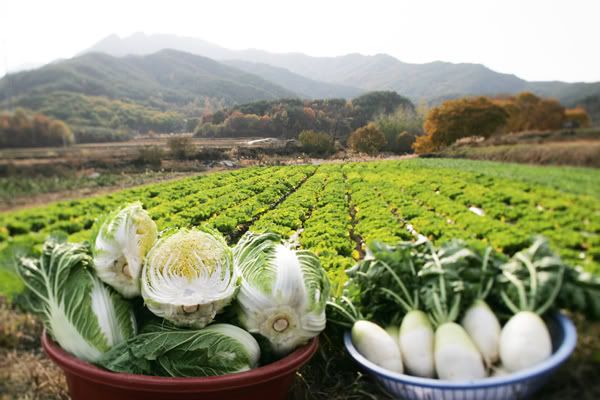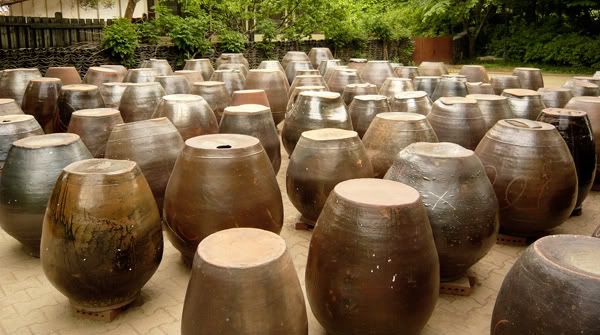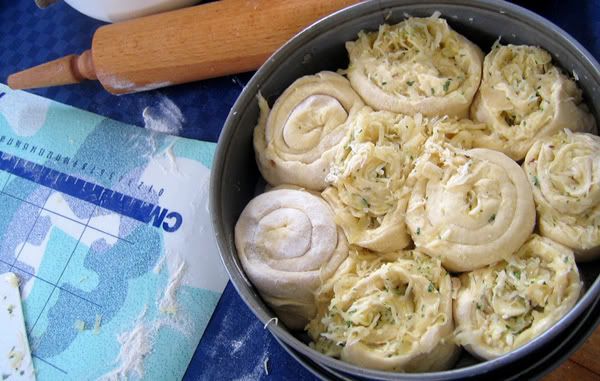Kimjang - Winter Cabbage in Korea and Alsace
The end of October saw the beginning of the kimjang (김장) season in Korea and, if the stock of local vegetable grocers is any indication, two weekends ago saw its close. For those of you not familiar with the term, 김장 is a traditional event in which families gather together to make kimchi (김치) for Um-dong (움동; the coldest three or four months of the year). Another important aspect of kimjang is the concept of pumasi (부마시; "mutual aid"), in which neighboring families help each other during this busiest time of the farmer's calender. According to the kimchitime website:
The number of cabbages prepared depended on the number of household members, usually between 100 and 200 cabbages. Considering the number of cabbages and amount of preparation for Kimjang, it was not a job for just 1 or 2 persons. People considered it as a major annual event, so close relatives, several neighbor housewives, and a few strong men all pitched in and worked together. People who participated in Kimjang helped wash cabbages, prepared materials, and stuffed ingredients inside each cabbage leaf.
The task usually lasted all day for 2-3 days, so the hostess treated each person to a big lunch every day. After the kimchi-making was done, she also gave some of the kimchi to the participants. When one of the other participants was ready to do their own Kimjang, all of members get together again to help her out. In this way, everyone finished their kimchi-making with help from everyone else.

[ Snow cabbage (배추; Brassica rapa pekinensis) and daikon radish (무; Raphanus sativus longipinnatus) from 김성윤의 Gourmet Club ]
Besides the obvious benefit of processing a large amount of cabbage all at once, pumasi also serves to strengthen local bonds and creates an in-group comprised of neighboring families and their associated kinship networks - bonds that can then be called upon later during times of distress. A couple weeks ago 美 mentioned being exhausted on account of her whole family gathering in 양주 over one weekend to make kimchi out of 180 cabbages; it's certainly not the type of work that I've ever participated in myself.
To show just how central kimjang is to agrarian Korean life, there is a specific numeral classifier (measure word) for the baechu cabbage (포기; pogi) and, according to Naver's online dictionary, the verb 담그다 can mean either "soak, steep" or "make/prepare kimchi, pickle [vegetables]". Thus, the process of soaking vegetables in water to ferment them for kimchi is described using conjugations of 김장 담그다. After all of the ingredients have been mixed together - variable depending on the type of kimchi one is making - the contents are stored in large ceramic pots and kept outdoors for the winter.

[ Kimchi pots by nile red ]
While the rapid urbanization of Korea's population in the decades following the Korean War and introduction and increased use of greenhouses to grow cabbage year-round have made kimjang less important than it was in the past, it still has the potential to draw neighbors together. All of my students at the academy live in high-rise apartment buildings; I do find it interesting though that the ones who know their neighbors best are also the ones who originally came from rural areas or who help their parents with kimjang. I wonder if a gradual loss of the pumasi tradition required to make large batches of kimchi - replaced by families purchasing factory-manufactured kimchi at the supermarket - can be a contributing factor to urban anomie in Korea.
Anywhere you walked in the central market district of Uijeongbu over the past month it was possible to see trucks loaded with cabbages and radishes - the two principle sources for making kimchi - driving around town. I regret not taking pictures of the mounds of vegetables piled chest-high, but despite passing through that part of town every day on my way home from Korean class I never did remember to bring my camera with me. Oddly enough though, I was reminded of kimjang over the weekend after a telephone conversation with my mother.
I don't recall how we arrived at the subject in the first place, but my mom mentioned how she had missed the time when she normally makes sauerkraut in preparation for the winter. (For readers in Korea - the linked article contains references to kimchi and avian bird flu. Consider yourself warned.) You see, my mother's ancestors are Alsatian and I grew up eating home-made sauerkraut. Eating it fresh is in a completely different league than the jarred stuff you can pick up in stores, and when heated with sausage to make a dish similar to choucroute garnie it becomes positively divine.

[ Sauerkraut Kartoffel Kuchen by tin.G]
Apparently my mom is going to set aside next weekend to making this winter's batch of sauerkraut, although the odds are against my seeing any of it. And in a slightly odd connection, Alsace and Gyeonggi-do have a sister province arrangement similar to the sister city agreements found worldwide. I guess this means I went from ethnic cuisine with a liberal use of fermented cabbage to ... a different ethnic cuisine with a liberal use of fermented cabbage, and the two decided to make an international union. Naturally this outreach wasn't based entirely on a vegetable, but of all the odds.